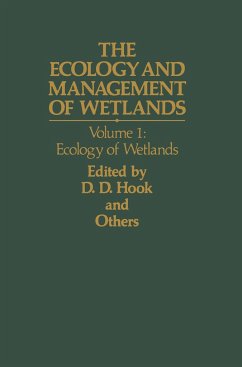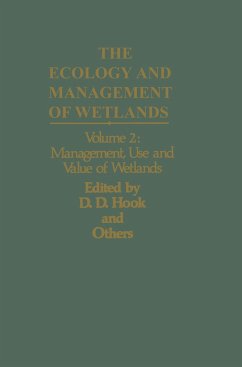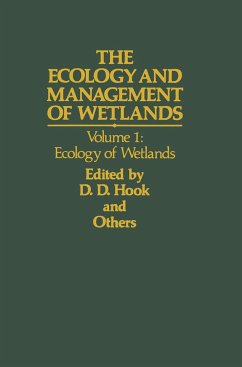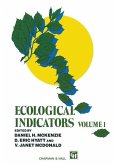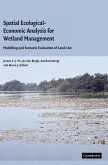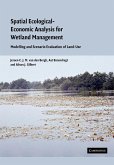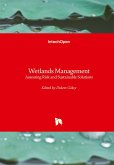Donal D. Hook, W. H. Jr. Mckee, H. K. Smith
The Ecology and Management of Wetlands
Volume 1: Ecology of Wetlands
Donal D. Hook, W. H. Jr. Mckee, H. K. Smith
The Ecology and Management of Wetlands
Volume 1: Ecology of Wetlands
- Broschiertes Buch
- Merkliste
- Auf die Merkliste
- Bewerten Bewerten
- Teilen
- Produkt teilen
- Produkterinnerung
- Produkterinnerung
This book contains the proceedings of a symposium held at the College of Charleston, Charleston, South Carolina, USA, 16-20 June 1986. The seed for this symposium arose from a group of physiologists , soU scientists and biochemists that met in Leningrad, USSR in July 1975 at the 12th Botanical Conference in a Session organized by Professor B.B. Vartepetian. This group and others later conspired to contribute to a book entitled Plant Life in Anaerobic Environments (eds. D. D. Hook and R. M. M. Crawford, Ann Arbor Science, 1978). Several contributors to the book suggested in 1983 that a…mehr
Andere Kunden interessierten sich auch für
![The Ecology and Management of Wetlands The Ecology and Management of Wetlands]() Donal D. HookThe Ecology and Management of Wetlands39,99 €
Donal D. HookThe Ecology and Management of Wetlands39,99 €![The Ecology and Management of Wetlands The Ecology and Management of Wetlands]() D. D. HookThe Ecology and Management of Wetlands39,99 €
D. D. HookThe Ecology and Management of Wetlands39,99 €![Ecological Indicators Ecological Indicators]() Daniel H. McKenzieEcological Indicators65,99 €
Daniel H. McKenzieEcological Indicators65,99 €![Spatial Ecological-Economic Analysis for Wetland Management Spatial Ecological-Economic Analysis for Wetland Management]() Jeroen C. J. M. BerghSpatial Ecological-Economic Analysis for Wetland Management133,99 €
Jeroen C. J. M. BerghSpatial Ecological-Economic Analysis for Wetland Management133,99 €![Spatial Ecological-Economic Analysis for Wetland Management Spatial Ecological-Economic Analysis for Wetland Management]() Jeroen C. J. M. van de BerghSpatial Ecological-Economic Analysis for Wetland Management45,99 €
Jeroen C. J. M. van de BerghSpatial Ecological-Economic Analysis for Wetland Management45,99 €![Contribution to the rational management of Ramsar sites in Guinea Contribution to the rational management of Ramsar sites in Guinea]() Urice Adine Bignon HounyoContribution to the rational management of Ramsar sites in Guinea26,99 €
Urice Adine Bignon HounyoContribution to the rational management of Ramsar sites in Guinea26,99 €![Wetlands Management Wetlands Management]() Wetlands Management84,99 €
Wetlands Management84,99 €-
-
-
This book contains the proceedings of a symposium held at the College of Charleston, Charleston, South Carolina, USA, 16-20 June 1986. The seed for this symposium arose from a group of physiologists , soU scientists and biochemists that met in Leningrad, USSR in July 1975 at the 12th Botanical Conference in a Session organized by Professor B.B. Vartepetian. This group and others later conspired to contribute to a book entitled Plant Life in Anaerobic Environments (eds. D. D. Hook and R. M. M. Crawford, Ann Arbor Science, 1978). Several contributors to the book suggested in 1983 that a broad-scoped symposium on wetlands would be useful (a) in facilitating communication among the diverse research groups involved in wetlands research (b) in bringing researchers and managers together and (c) in presenting a com prehensive and balanced coverage on the status of ecology ami management of wetlands from a global perspective. With this encouragement, the senior editor organized a Plan ning Committee that encompassed expertise from many disciplines of wetland scientists and managers. This Committee, with input from their colleagues around the world, organized a symposium that addressed almost every aspect of wetland ecology and management.
Produktdetails
- Produktdetails
- Verlag: Springer / Springer US / Springer, Berlin
- Artikelnr. des Verlages: 978-1-4684-8380-2
- 1988
- Seitenzahl: 620
- Erscheinungstermin: 18. Mai 2012
- Englisch
- Abmessung: 235mm x 155mm x 34mm
- Gewicht: 926g
- ISBN-13: 9781468483802
- ISBN-10: 1468483803
- Artikelnr.: 41323627
- Herstellerkennzeichnung
- Springer-Verlag GmbH
- Tiergartenstr. 17
- 69121 Heidelberg
- ProductSafety@springernature.com
- Verlag: Springer / Springer US / Springer, Berlin
- Artikelnr. des Verlages: 978-1-4684-8380-2
- 1988
- Seitenzahl: 620
- Erscheinungstermin: 18. Mai 2012
- Englisch
- Abmessung: 235mm x 155mm x 34mm
- Gewicht: 926g
- ISBN-13: 9781468483802
- ISBN-10: 1468483803
- Artikelnr.: 41323627
- Herstellerkennzeichnung
- Springer-Verlag GmbH
- Tiergartenstr. 17
- 69121 Heidelberg
- ProductSafety@springernature.com
Chris Brooks is Professor of Finance at the ICMA Centre, University of Reading, UK, where he also obtained his PhD. He has published over 60 articles in leading academic and practitioner journals including The Journal of Business, The Journal of Banking and Finance, The Journal of Empirical Finance, The Review of Economics and Statistics and The Economic Journal. He has also acted as consultant for various banks and professional bodies in the fields of finance, econometrics and real estate.
I. The Resource.- 1. Global Wetlands - History, Current Status and Future.- 2. The Functions of a Pristine Estuarine Ecosystem.- 3. Aquatic Animal Production and Wetland Relationships: Insights Gleaned Following Wetland Loss or Gain.- River Regulation Effects on Floodplain Hydrology and Ecology.- 5. Expertise in Wetlands Research and Management: The Need and Some Priorities for North-South Transfer.- II. Hydrologic and Water Quality Values of Wetlands.- 6. A Review of the Recharge-Discharge Function of Wetlands.- 7. Some Comments on the Relation Between Ground Water and Wetlands.- 8. Water Quality Functions of Wetlands: Natural and Managed Systems.- 9. Analysis of Flood Peak Moderation by Depressional Wetland Sites.- 10. Physical and Biological Control of Mangrove Pore Water Chemistry.- 11. The Value of Wetlands in Low Relief Landscapes.- 12. Wetland Evapotranspiration in Temperate and Arid Climates.- 13. Role of Coastal Marshes in Energy Dissipation and Shore Protection.- 14. Ground-water and Surface-water Interactions in Minnesota and Wisconsin Wetlands.- III. Biological Values of Wetlands.- 15. Wetlands and Their Relationship to Migrating and Winter Populations of Waterfowl.- 16. Aquatic Habitats of Breeding Waterfowl.- 17. Coastal Wetlands - Major Ecological Entities for Wading and Shore Birds.- 18. Mammals and Wetlands.- 19. Endangered, Threatened and Rare Wetland Plants and Animals of the Continental United States.- 20. Aquatic Invertebrates of Freshwater Wetlands: Function and Ecology.- IV. Formation, Chemistry and Biology of Wetland Soils.- 21. Soil Formation Under Hydromorphic Conditions.- 22. Characterization and Origin of Delmarva Bay Basin Fill.- 23. Gas Exchange and Atmospheric Properties of Flooded Soils.- 24. Chemistry of Metals and Trace Elements ina Submerged Soil.- 25. Phosphorus Transformations in Flooded Soils.- 26. Carbon and Nitrogen Dynamics in Wetland Soils.- 27. The Influence of Redox Potential on the Environmental Chemistry of Contaminants in Soils and Sediments.- 28. Wetland Soils with High Sulfide Contents.- 29. Soil Nitrogen, Phosphorus and Organic Carbon in Transplanted Estuarine Marshes.- V. The Tolerance of Plant Species to Wetland Sites.- 30. Biochemical Adaptations to Anoxia in Barnyard Grass.- 31. Involvement of the Hormones Ethylene and Abscisic Acid in Some Adaptive Responses of Plants to Submergence, Soil Waterlogging and Oxygen Shortage.- 32. Nutrient Uptake and Acclimation to Soil Waterlogging and Oxygen Shortage in Non-wetland Plants.- 33. Cytoplasmic Acidosis and Flooding Tolerance in Crop Plants.- 34. The Relationship of Soil Parameters and Root Metabolism to Primary Production in Periodically Inundated Soils.- 35. Mineral Nutrition of Oxygen-stressed Crops and its Relationship to some Physiological Responses.- 36. Responses of Woody Seedlings to Elevated Flood Water Temperatures.- 37. Ultrastructure Studies as a Means of Evaluating Plant Tolerance to Flooding.- 38. Use of Oxygen Microelectrodes to Measure Aeration in the Roots of Intact Tree Seedlings.- 39. Flood Tolerance Indices for Palustrine Forest Species.- 40. Interspecific Genetic Variation of Loblolly Pine Tolerance to Soil Waterlogging.- VI. Estuarine Wetlands and Interactions Among Their Components.- 41. Pathways and Controls of the Carbon Cycle in Salt Marshes.- 42. Irregularly Flooded Salt Marshes of the Gulf and Atlantic Coasts of the United States.- 43. A Comparison of Vascular Plant Communities in Tidal Freshwater and Saltwater Marshes.- 44. Herbivore Population Dynamics in Intertidal Marshlands: The Role of Host Plant Nutrition.- 45. The Utilization of Seagrass Meadows by Fishery Organisms.- 46. A Comparison of Fish and Invertebrate Community Composition in Tidal Freshwater and Oligohaline Marsh Systems.- 47. Pattern and Process in Arid-region Salt Marshes - Southern California.
I. The Resource.- 1. Global Wetlands - History, Current Status and Future.- 2. The Functions of a Pristine Estuarine Ecosystem.- 3. Aquatic Animal Production and Wetland Relationships: Insights Gleaned Following Wetland Loss or Gain.- River Regulation Effects on Floodplain Hydrology and Ecology.- 5. Expertise in Wetlands Research and Management: The Need and Some Priorities for North-South Transfer.- II. Hydrologic and Water Quality Values of Wetlands.- 6. A Review of the Recharge-Discharge Function of Wetlands.- 7. Some Comments on the Relation Between Ground Water and Wetlands.- 8. Water Quality Functions of Wetlands: Natural and Managed Systems.- 9. Analysis of Flood Peak Moderation by Depressional Wetland Sites.- 10. Physical and Biological Control of Mangrove Pore Water Chemistry.- 11. The Value of Wetlands in Low Relief Landscapes.- 12. Wetland Evapotranspiration in Temperate and Arid Climates.- 13. Role of Coastal Marshes in Energy Dissipation and Shore Protection.- 14. Ground-water and Surface-water Interactions in Minnesota and Wisconsin Wetlands.- III. Biological Values of Wetlands.- 15. Wetlands and Their Relationship to Migrating and Winter Populations of Waterfowl.- 16. Aquatic Habitats of Breeding Waterfowl.- 17. Coastal Wetlands - Major Ecological Entities for Wading and Shore Birds.- 18. Mammals and Wetlands.- 19. Endangered, Threatened and Rare Wetland Plants and Animals of the Continental United States.- 20. Aquatic Invertebrates of Freshwater Wetlands: Function and Ecology.- IV. Formation, Chemistry and Biology of Wetland Soils.- 21. Soil Formation Under Hydromorphic Conditions.- 22. Characterization and Origin of Delmarva Bay Basin Fill.- 23. Gas Exchange and Atmospheric Properties of Flooded Soils.- 24. Chemistry of Metals and Trace Elements ina Submerged Soil.- 25. Phosphorus Transformations in Flooded Soils.- 26. Carbon and Nitrogen Dynamics in Wetland Soils.- 27. The Influence of Redox Potential on the Environmental Chemistry of Contaminants in Soils and Sediments.- 28. Wetland Soils with High Sulfide Contents.- 29. Soil Nitrogen, Phosphorus and Organic Carbon in Transplanted Estuarine Marshes.- V. The Tolerance of Plant Species to Wetland Sites.- 30. Biochemical Adaptations to Anoxia in Barnyard Grass.- 31. Involvement of the Hormones Ethylene and Abscisic Acid in Some Adaptive Responses of Plants to Submergence, Soil Waterlogging and Oxygen Shortage.- 32. Nutrient Uptake and Acclimation to Soil Waterlogging and Oxygen Shortage in Non-wetland Plants.- 33. Cytoplasmic Acidosis and Flooding Tolerance in Crop Plants.- 34. The Relationship of Soil Parameters and Root Metabolism to Primary Production in Periodically Inundated Soils.- 35. Mineral Nutrition of Oxygen-stressed Crops and its Relationship to some Physiological Responses.- 36. Responses of Woody Seedlings to Elevated Flood Water Temperatures.- 37. Ultrastructure Studies as a Means of Evaluating Plant Tolerance to Flooding.- 38. Use of Oxygen Microelectrodes to Measure Aeration in the Roots of Intact Tree Seedlings.- 39. Flood Tolerance Indices for Palustrine Forest Species.- 40. Interspecific Genetic Variation of Loblolly Pine Tolerance to Soil Waterlogging.- VI. Estuarine Wetlands and Interactions Among Their Components.- 41. Pathways and Controls of the Carbon Cycle in Salt Marshes.- 42. Irregularly Flooded Salt Marshes of the Gulf and Atlantic Coasts of the United States.- 43. A Comparison of Vascular Plant Communities in Tidal Freshwater and Saltwater Marshes.- 44. Herbivore Population Dynamics in Intertidal Marshlands: The Role of Host Plant Nutrition.- 45. The Utilization of Seagrass Meadows by Fishery Organisms.- 46. A Comparison of Fish and Invertebrate Community Composition in Tidal Freshwater and Oligohaline Marsh Systems.- 47. Pattern and Process in Arid-region Salt Marshes - Southern California.

